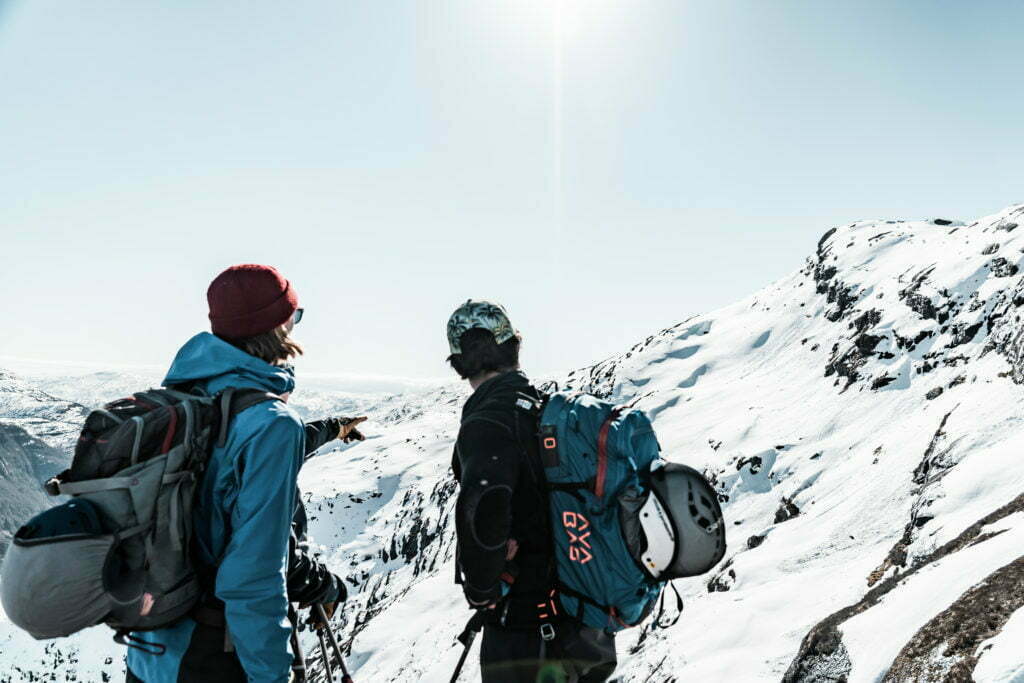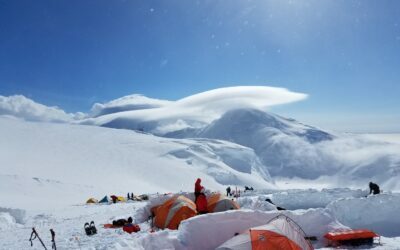Civilised trail-breakers don’t murder their friends
The ascent begins. Someone hoiks their heel lifts, unzips their GoreTex under the armpits and sets off for the summit at warp speed. Oh, no. It’s going to be one of these, then. We’ve all been there. The gasping for air begins rapidly. Layers are removed. Spurious “technical breaks” to fiddle with the heel bars come every couple of minutes. Laboured kick-turns on the steep bits. The chocolate muesli bars are gone before you’re half-way up. When you summit, you’re drenched in sweat, leaking lactic acid, head throbbing, wondering if you’ll have the muscle to hold an edge on the scary bit 500 metres below. Is the pain worth it? Well… no. It’s totally unnecessary. We guarantee that if you take it a little easier, and follow a more civilised line up, you’ll get to the top in basically the same time and you’ll be able to enjoy the view.Listen to experienced mountaineers
DThe tanned, trim 60-year-old guide who travels thousands of meters altitude every week goes at a snail’s pace and won’t touch the heel bar unless they have to. And, actually, have you ever wondered why rando-race bindings don’t have the highest level of heel-lift? Youthful confidence is awesome. But when it comes to walking safely and efficiently in the mountains, do as the elders do. If you’re keeping your powder dry for the descent, you’re doing it right. Sprinting uphill for exercise is valid, knock yourself out, go for it – but if it’s a multi-day trip with a peak a day then the advice below will be more than useful! Laying a good trail up the mountain is an art. It should be cultivated! Be cunning. Save your energy for the descent. Don’t blow up your posse. Keep it safe and smooth. Minimise risk.Safer touring
Here are some simple, concrete and useful tips on using judgment to find safe routes up the mountain. It is not always easy. But it’s strictly necessary to stay safe and to get good skiing. The aim is the maximum number of descents before retirement with nothing broken and no one lost.

The five basic pillars of hitting the slopes with skins under your skis!
A truly competent, experienced, ski guide would probably say there are about twenty basic rules. We’re sticking to five to make it as concrete as possible. Consider them the basic pillars of laying down ski tracks the right way – a checklist of things to remember the next time you point your skis to the peat.
1. Minimise your exposure to risk
Minimise your exposure to risk. The most notorious risk on steep snow-cover is, of course, avalanche. There are also injuries of all kinds; dangerous snow formations; other skiers; snow falling from trees; falling rocks. Possible harm or very great inconvenience, basically. Before you set out, plan a little. Read about the route; put yourself in it. Ask yourself: “What can get you on this tour and how?” Answering this tells you what to avoid. You might also do this when you’re standing on flat ground looking up at the mountain, tracing possible lines up. Identify terrain traps, avalanche trigger points and avalanche terrain. And avoid them, too. Imagine that you’re all looking up at a mountainside and assessing the terrain as so complex that it’s difficult to find a safe route. Is it essential to go up this way if you can find safer alternatives around the corner? For those familiar with ATES/KAST terrain classification, you might recognise this as Class 2 terrain just from the little we write here. And what does that mean? Does your party have the capacity, knowledge and grounding to handle this?2. Efficiency
Once you’ve picked out areas less prone to avalanches, you can try to link these zones to consistent, lower-angled terrain allowing you to maintain a relatively gentle and efficient track. Aim for the track to be no steeper than 12° to 15°. WHAT!? Only 12 to 15 degrees? That’s right. Just because lean, mean rando-race machines are capable of skinning up a 22° incline at warp speed doesn’t make it makes sense. For most of us, ditching the heel bars and taking a more relaxed route really pays off. You keep your heart rate down, you sweat less, and produce less lactic acid. The energy you save is better spent on the tour’s principle purpose – the descent.
Perfect, smooth tracks. Photo: Crister Næss
Climbing an easier trail allows you to communicate more effectively with the others in your party. Not least because you’re not stacked one on top of another, repeatedly kick-turning. We know that poor communication is one of the main causes of avalanche incidents, so going slow and keeping a pace that allows everyone enough time to communicate make sense! If you go so steeply or fast no one can talk, it comes at the expense of communication. An easy ascent, at a civilised pace, means that we avoid gasping for air and frequent use of the heel elevator. Did you know that on average you spend close to half a minute every time you fiddle with the heel bar? Do it 6 to 7 times with people behind you on the ascent and you can be sure there will be stirs of annoyance. Go, rather, for a smooth and safe track and keep a steady rhythm. It’s the best for everyone. Kick turns, incidentally, are the enemy of good rhythm and communication. The kick turn is an essential manoeuvre; it’s something we all need to have in the toolkit. But it’s something we should all learn how to avoid having to do in the first place. Does anyone, honestly, want to have to perform a single more kick turn than is absolutely necessary? No. On a perfect powder day, with blue skies and gorgeous conditions, round, easy, gentler curves are the order of the day. And it’s more efficient than the kick turn, that’s absolutely for sure! Make long, consistent sections when you’re breaking trail, and rounded turns when you have to avoid steeper terrain, danger, or to connect to another part of the slope with low exposure and a kinder angle. There is no magic, ideal, gradient. The ideal trail is the trail in which the party doesn’t exhaust itself, and can continue to think ski-related thoughts: the snow; the view; the power of hot chocolate. If you’re in the lead, and you can hear your friends below you cursing as they battle up the steep sections, this isn’t the ideal trail. There’s nothing wrong with attempting to avoid lifting the heel bars – keep them down and go as steep as comfort allows. “Go the steep way,” the heel lifts sing. Ignore their siren song. As the track packs down, it becomes more slippery. Listen to your lungs instead.3. Gather information
If you’re on the best track, you should also maximise opportunities to collect observations – snow cover, terrain, conditions. If a detour of a few hundred meters allows you to dig a “quickpit” or to glean relevant or similar information about the snow cover you intend to ski down, then it’s worth it. With another in the party, you can even do a quick compression test.
Snow profiles, quick shovel tests, speedy “quickpits” and anything else you can do to get more information about the snow cover are very useful! Photo: Crister Næss
We’ve started a tour with some parameters jotted down in a notebook. If we’re worried, for example, that we may to have to traverse wind-slabbed snow, or there’s the risk of fracture propagation, then we can try to make tracks through a corresponding but safe part of the face we plan to ski. This is useful information to have before we make altitude. In short, your galaxy-superbrain-level tracks keeps you safer, fresher in your legs, and now wiser for any decisions you may have to make and for the descent itself. Well done!4. Communicate and have fun!
Are we having fun yet? Well – not necessarily, no, not if we’re hammering uphill, heat-rates high, heel bars as high as they’ll go. Not much bandwidth for chat. On a week-long cabin trip, we can get away with a day or two of this. A week’s pushing it, though. If it dumps 50cm overnight, it’ll be preferable to hit the steeps rather than be lying prostrate on your bunk unable to bend your legs.
It never hurts to take a breather, swap observations and check in. Photo: Sverre Hjørnevik
Take a breather, make a decision, make an observation in the best place for it. It may as well be beautiful if you have to do it anyway. Whenever possible, make it a nice, flat place where everyone can hang out and have a nice moment. You know it when you see it. A group of six skiers strung through a steep slope in a dense forest, say, probably isn’t it. Keeping the atmosphere nice also facilitates communication. Keeping a civilised pace and choosing a relaxed, pleasant place to stop, keeps the conversation going. A mood conducive to conversation is the right mood to maintain an active culture of teamwork and shared observations.5. Look at my mighty works and praise my genius
Before you tear off the skins, lock your heels (or leave them free for bonus points), climb aboard the split board and make the final decision – take a moment. Turn around. Enjoy the elegant, agile, carefully crafted route to the peak. These tracks should ideally look as if someone just floated up the mountain on a magic carpet of wisdom, experience and propitious information. Make your tracks a signature. A sign of mastery. You should look down the mountain and notice others actively choosing your track rather than the high angle alternative with its kick turns and frozen sweat!
Smooth lines and fresh tracks in the snow. Almost like a work of art where the ski tracks are carefully selected brushstrokes. Seriously. Photo: Sverre Hjørnevik
In short, be proud of the trail you break. People should feel relaxed, safer and more stoke-filled after following your lead. And now – check in with the crew. Lock your heels or let them hang free. Reap what you have sown. This is what it’s for, and it’s basically the best thing in the world.
Waxing and prepping alpine touring skis
We don’t put in all that effort just for the view. We do it for the way down. So let’s talk about glide wax. It provides better glide, protects the sole from wear. The specific wax, even how carefully you do the work, isn’t really so important – it’s not a race. And it doesn’t have to be complicated at all…

Tailoring long skins for alpine touring
Wondering how to tailor your skins for alpine touring? Here’s an overview – care and trimming long skins for touring skis.

Field repair kit
Bringing a repair kit can be very useful, even if you’re not going on a long expedition. Preparation, as always, is never a bad thing.

17 excellent gear hacks for the wilds
If you’re heading out to the hills, you want to pack as light as possible. In which case, your stuff must multi-task. In that spirit, here are 17 of the best gear hacks we know.

Preparing for Åsnes Expedition Amundsen
Dreaming of an adventure in the winter mountains? Or a lover of endurance races? Maybe Åsnes Expedition Amundsen is for you. But you’ll need to be ready.

How to feed a hunting dog
Correct nutrition is the alpha and omega for a healthy, strong and happy hunting dog performing to its limits day after day in the mountains. A well-trained hunting dog can quickly cover more than 60 km in hilly terrain, marshes and woods. So if you’re out for a number of days, feeding is everything.